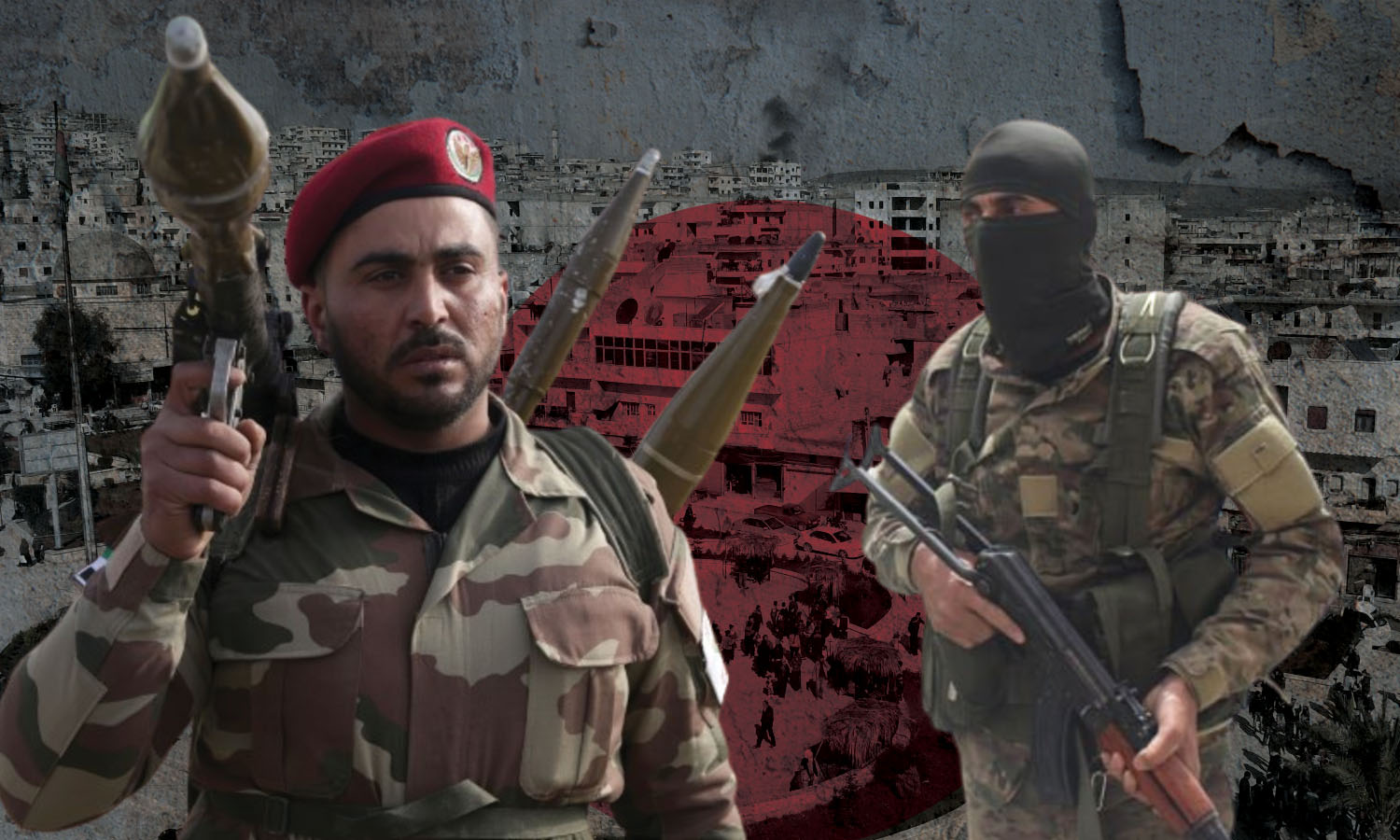


Members of Hayat Tahrir al-Sham (HTS) and the Syrian National Army (SNA) (modified by Enab Baladi)


Khaled al-Jeratli | Hassan Ibrahim | Hussam al-Mahmoud | Jana al-Issa
The recent infighting between opposition factions north of Aleppo changed the nature of alliances in the region, especially with the formation of an alliance that included factions that were known to be among the most hostile to each other.
The parties to the conflict north of Aleppo were divided into two groups, the first consisting of the Sultan Suleiman Shah Division (al-Amshat) and the Hamza Division (al-Hamzat) of the Turkey-backed Syrian National Army (SNA), together with Hayat Tahrir al-Sham (HTS), which had been hostile to the said factions for years. The second group comprises the Third Legion, which includes a set of SNA factions.
The HTS has long accused today’s allies of being the source of corruption in northern Syria, while they threw back accusations on multiple occasions, calling its leader Abu Mohammad al-Jolani and HTS elements numerous names, such as “Khawarij” and “terrorists.”
The fighting broke out against the backdrop of Hamza Division fighters assassinating media activist Mohammad Abdul-Latif (Abu Ghannoum) and his pregnant wife in al-Bab on 10 October. This assassination, however, was nothing more than a spark that ignited the haystacks.
Last February, a tripartite committee investigating the violations of the Sultan Suleiman Shah Division announced the dismissal of its leader, Mohammed al-Jassem, known as Abu Amsha, from all tasks entrusted to him in what appeared to be signs of his trial for numerous violations attributed to him.
Only a month after these trials ended, Abu Amsha appeared in the Atmeh area on a visit to his relatives within HTS-held areas.
This was preceded by a gesture that was considered the first of its kind when Abu Amsha expressed his willingness to reach an understanding with HTS and to participate alongside it in fighting the regime within the “leadership and umbrella of the Syrian National Army (SNA).”
This prelude to the establishment of relations with HTS was evident in the recent fighting that first arose between factions of the SNA-affiliated Third Legion confronting the Hamza Division (al-Hamzat) and the Sultan Suleiman Shah Division (al-Amshat), which quickly sought the assistance of HTS by entering some of the latter’s convoys to its areas of control in Afrin.
SNA factions control the northern and eastern countryside of Aleppo with Turkish support, while HTS controls the Idlib region.
The political researcher at the Omran Center for Strategic Studies, Maan Talaa, told Enab Baladi that the relationship between the parties to this alliance is interest-driven for HTS and existential for the other two factions.
Abu Amsha is aware that his current options in northern Aleppo have become limited, especially with his reputation among Syrians as one of the most prominent figures to whom violations against civilians are attributed.
This prompted him to search for a military force that might create “balance” for his situation with the SNA factions. The same applies to al-Hamzat.
Meanwhile, experiences with HTS have proven that it is always seeking a party or a situation to be its entrance towards a specific event or a certain area, according to Talaa.
He pointed out that the form of today’s alliance does not necessarily reflect HTS’ wish to work or to ally with al-Amshat and al-Hamzat; rather, it is seeking a cover to “extend its influence to northern Aleppo.”
Talaa reckoned that this strategy in alliances falls under the classification of an “alliance of convenience” as far as HTS is concerned, which has been the case for its alliances since its disengagement from al-Qaeda to date. Meanwhile, he considered it an “existential alliance” for the other two factions.
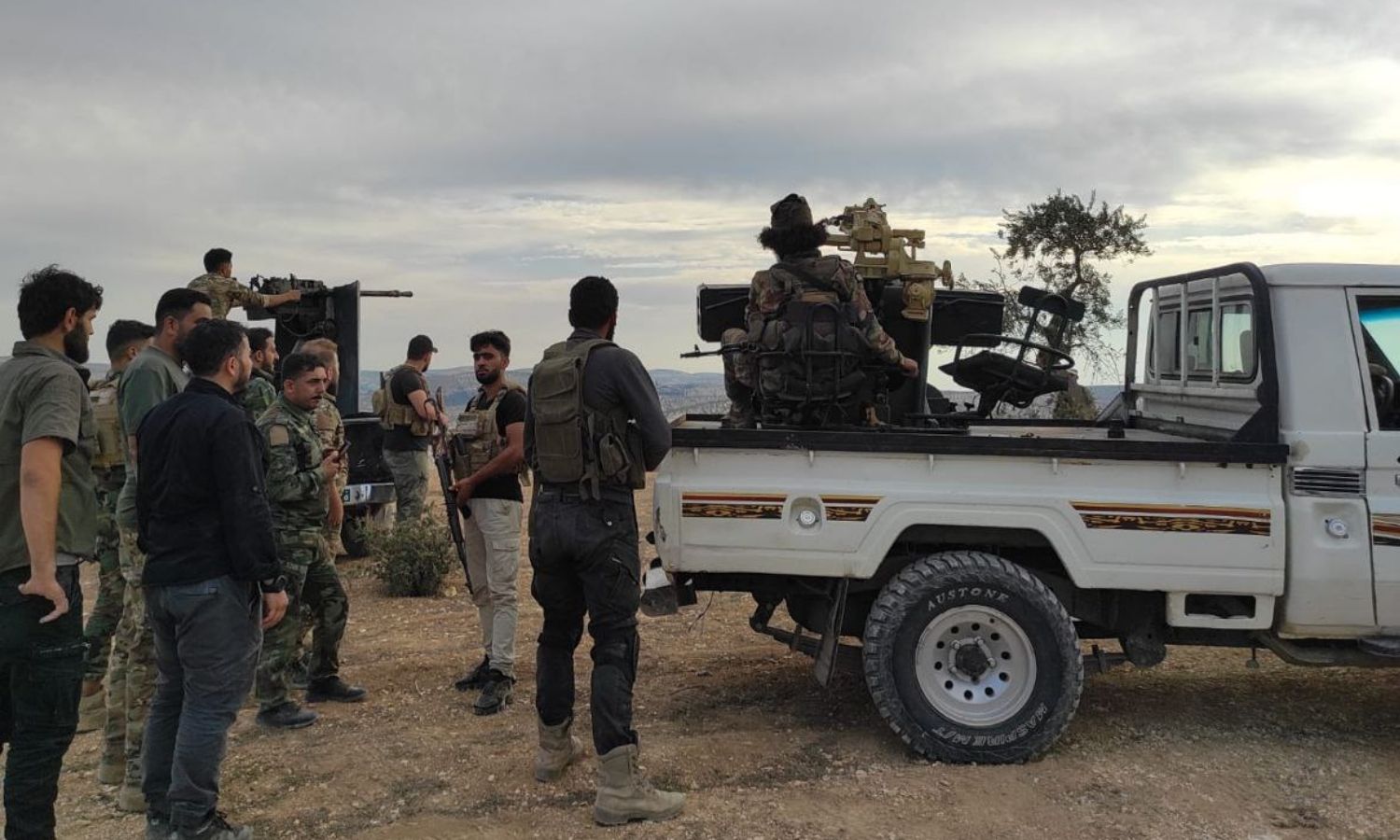
Forces of the Turkish-backed Syrian National Army’s Third Legion in Afrin, north of Aleppo, 12 October 2022 (Third Legion correspondent)
This is not the first time that HTS has mobilized its forces in the area to storm SNA-controlled areas north of Aleppo, which makes us aware that HTS has a preconceived vision for this region in general, according to researcher Maan Talaa.
In order to comprehend HTS’ vision of the region, Talaa said that HTS viewed the areas from Kafr Jannah to Jindires in the countryside of Aleppo as its own security belt.
The state of alliances today has nothing to do with the balance of power in northwestern Syria, Talaa said. It is obvious that HTS is the strongest party, and therefore it can ignore the state of hostility with other factions in its alliances of convenience in the region.
Surely, HTS’ operational formula is not divisible by two. Therefore, what is happening with HTS and its allies cannot be viewed as a genuine alliance that could last for long.
Talaa added that HTS operates at all security, military, and even service levels individually and prefers not to engage others in management.
This analysis by researcher Talaa intersects with the terms of the agreement between the parties to stop the fighting that was approved on the evening of 14 October, although its implementation remains questionable and controversial.
The agreement stipulates that the Third Legion will only have its military activity, which means a greater HTS role in managing the region, as noted in the last clause, which states that “consultation and deliberations to arrange and reform civilian institutions shall continue in the next phase.”
As factional fighting began from the city of al-Bab, east of Aleppo, between al-Hamzat and the Third Legion, the al-Amshat faction entered the line of confrontations in support of al-Hamzat and announced new fronts in Afrin.
As soon as the al-Amshat entered the confrontations, HTS began to penetrate into SNA-held areas against the Third Legion, supporting its enemies in the fighting.
In response to Enab Baladi’s questions, the Third Legion commented on this coalition at the time, saying that the al-Amshat had smuggled HTS fighters to their stronghold in the Sheikh al-Hadid region, northwest of Afrin to launch a simultaneous multi-axed attack against the Third Legion.
Answering Enab Baladi’s questions, The Public Relations Office of the Sultan Suleiman Shah Division (al-Amshat) said that the faction “basically did not fight anyone,” wondering how it ended up classified as part of an alliance alongside HTS and al-Hamzat.
The faction’s efforts were geared towards attempts to resolve the dispute and mediate an end to the fighting, which “does not serve the scene and the revolution,” the office said. However, it was surprised by a “sudden attack” towards Sheikh al-Hadid from Third Legion sectors in the town of Erende.
It considered what occurred in the western countryside of Afrin to be a case of self-defense, as it was “defending the faction and the displaced inhabitants of the region against aggression.”
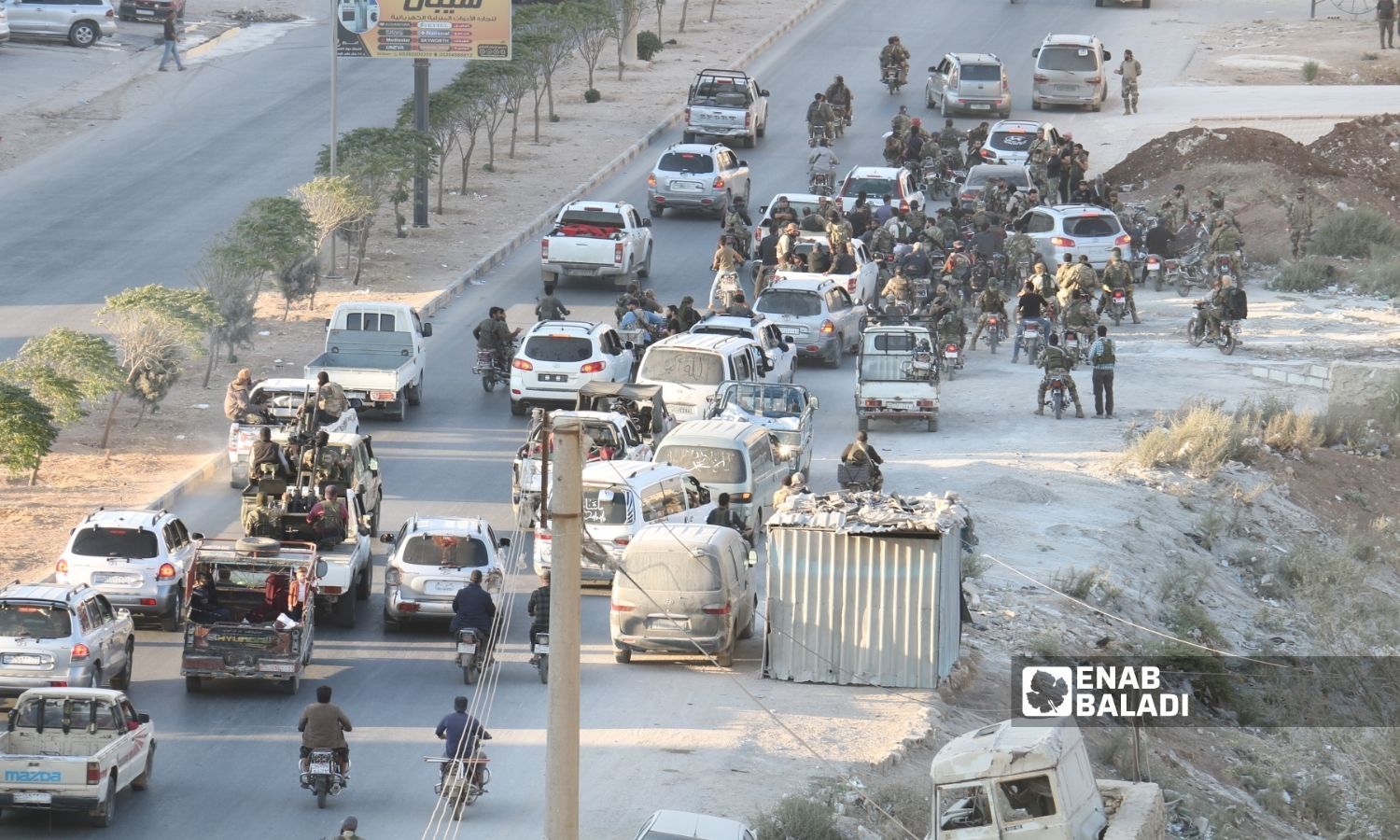
A group of the Third Legion of the Turkish-backed Syrian National Army (SNA) at the western entrance to the city of Azaz after its withdrawal from Afrin in the countryside of Aleppo – 13 October 2022 (Enab Baladi)
Al-Amshat’s Media Office said that its faction, along with the Hamza Division, took a position entitled “zero problems with everyone,” referring to its relationship with Hayat Tahrir al-Sham (HTS).
It considered that from the moment the said policy was adopted, the enemies of these factions were the regime and its allies, the Kurdistan Workers’ Party (PKK), and the Islamic State (IS).
It also pointed out that all factions fighting these parties are “allies and friends,” taking on Turkey and Qatar as “strategic allies.”
The al-Hamzat and al-Amshat factions face accusations of being more subordinate to Turkey than the rest of the SNA factions, given the numerous visits of Turkish intelligence figures to these factions, particularly during previous periods.
Three projects
The political researcher at Jusoor Center for Studies, Wael Alwan, considered that this fighting between opposition factions draws actual alliances between these factions, most of which will be more durable and stable than its predecessors but will divide SNA fractions into three sections.
The first section is the Third Legion with its factions and allies from the Liberation and Construction Movement (LCM). But it may lead to a restructuring within the Legion due to the division within it, as some other groups and factions could withdraw or join it.
Alwan considered that if this SNA bloc did not change its mindset, it would continue to be pressured, considering that other factions were not interested in the Third Legion’s “unification” initiative.
The second alliance is the HTS alliance, which recently became a solid partnership and coalition due to other military events. It goes without saying that this military bloc is the “traditional sworn enemy” of Third Legion components.
Al-Hamzat, al-Amshat, and the 23rd Division (Ahrar al-Sham, the Eastern Sector) are at the head of this bloc. Even if HTS withdraws from the region, it will not leave before it is assured of its interests there through its allies.
HTS’ reassurance of its interests lies in empowering and strengthening its partners in the region and building the capacity of continuous security interaction with them, according to Alwan.
The third bloc of these factions is represented by those groups that stood on the sidelines of the recent fighting for a variety of reasons, not because they are one alliance but the common link between them is that they left a margin for interaction with HTS’ project in case it becomes a reality in the region, unlike the Third Legion, which lost that advantage.
The current battles are not new to the Syrian opposition factions, as the region has witnessed much internal fighting over the past years, some of which led to the dissolution of major military factions. However, what is new is the expansion of the circle of “spectators” or those with formal positions.
With the start of hostilities between the opposition factions in eastern Aleppo countryside, specifically in the vicinity of the city of al-Bab, the Ministry of Defense of the Turkish-backed Syrian Interim Government (SIG) issued a statement calling on the SNA factions to “not resort to weapons in order to prevent bloodshed and for the security and legal institutions to take action against the criminals and their supporters, including knowing the motives for the murder of the activist (Abu Ghannoum).”
The battles on the ground were accompanied by political moves by the authorities responsible for the region, but in a different direction that does not reflect what is happening on the ground and is not related to it. The head of the Interim Government, Abdul-Rahman Mustafa, inaugurated the magnetic resonance center in the city of al-Rai in the northern countryside of Aleppo, coinciding with the intensification of battles.
Mustafa also met a day later at the government headquarters in Aleppo countryside with the head of the Raqqa Governorate Council to discuss the service and economic reality and the problems facing the agricultural sector to “develop the agricultural reality.”
On 13 October, Mustafa held a meeting at the government headquarters, which included a delegation of farmers to discuss the economic reality, and the attendees discussed the available capabilities, obstacles, and problems facing farmers.
The opposition’s Syrian National Coalition (SNC) did not issue its second comment on the fighting until 14 October, three days after the fighting erupted.
The statement denounced the resorting of military factions to weapons in solving problems and called on everyone to immediately stop the fighting in order to prevent bloodshed and to preserve the gains of the revolution in the regions.
The National Coalition considered that the fighting “offense the Syrian revolution,” pointing out that the judiciary is the way to address any disputes or problems and to arbitrate those with opinion and wisdom in major cases and not resort to fighting.
This was followed by the appearance of the official spokesman for the Ministry of Defense in the Syrian Interim Government, Brigadier General Ayman Sharara, through a video recording from the city of Afrin, north of Aleppo, to confirm that the city is free of “armed manifestations.”
Sharara said during the video recording that he took near the center of Afrin city that it is the Interim Government that oversees the management of the security situation in Afrin through its military and civilian police branches.
Two days after the confrontations, Enab Baladi’s correspondent in the countryside of Aleppo met with the commander of the Third Legion’s operations room, Brig. Gen Abdul-Salam Hamidi, in the Kafr Jannah district, west of Azaz, who considered that all factions “have an interest in what is happening.”
Hamidi considered that what is happening is an “integrated conspiracy against the (Third Legion), which came out to support the oppressed.”
Wissam al-Qassoum, a member of the Syrian Islamic Council and who is close to the Third Legion, told Enab Baladi the reason for the absence of an initiative for a solution, mediation, or intervention in order to stop the fighting and the progress of Tahrir al-Sham, after five days of clashes, is that there is a desire by the leader of Tahrir al-Sham, Abu Mohammad al-Jolani, and his followers to eliminate the Third Legion or to restrict it economically and geographically.
Before the HTS entry to Afrin, al-Qassoum appeared alongside leaders of the Third Legion on 12 October, through a video recording, saying that the battle that the Legion is waging is “a battle of revolution, not a battle to establish influence or control.”
The positions of the Interim Government were met with denials by al-Qassoum, who posted on Twitter that Tahrir al-Sham convoys are still moving from Afrin to the fighting axes in Kafr Jannah.
Enab Baladi asked the official spokesman for the Interim Government’s defense ministry, Brig. Gen Ayman Sharara, about the position of the leadership of the Syrian National Army on the alliances between the al-Hamzat and al-Amashat fractions with Tahrir al-Sham to fight the Third Legion and its position regarding the arrival of Tahrir al-Sham to the areas of influence of the National Army, but it did not receive a response until the moment of publishing this report.
The alignment of al-Hamzat and al-Amshat alongside Tahrir al-Sham revealed the rift between the components of the Syrian National Army, and the stance of many of the latter’s factions deepened it, which placed them in the circle of collusion, accusation, and betrayal.
The most prominent of these factions is the Sham Legion, which owns sites in the Idlib and Aleppo regions, and its stationing points are spread north of Aleppo, and it did not stand in the way of the progress of Tahrir al-Sham, which is the second time in months, and it was previously accused of “treason” when HTS convoys entered Afrin countryside last June.
The Sham Legion, which is close to Turkey, did not comment on the accusations, although, last June, it issued a statement in response to previous accusations, and at the time blamed the National Army, stating that it informed the latter and its components (the three corps) of the military buildup of Tahrir al-Sham.
The local faction demanded the other armed groups to send forces and reinforcements to the area, and its requests were met with the factions contenting themselves with remaining in their areas of control, leaving the Sham Legion alone in an area that shares 30 kilometers with the areas of control of Tahrir al-Sham in Idlib.
The number of factions affiliated with the Syrian National Army (SNA) and the different alignments and tense relations among them made it difficult to enumerate the factions that were neutral in the fight with Tahrir al-Sham.
| Among the most prominent factions that distanced themselves from the fighting are: the North Falcons Brigade, Suqur al-Sham, the Ninth Division, Legion of Glory, Corps of Rahman, 112th Brigades, 113th Brigades, Sultan Mohammad al-Fateh Division, al-Mu’tasim Division, al-Muntasir Billah Division, Elite Army, Jaysh al-Izza groups, Jaysh al-Nasr, Samarqand Brigade, Malik Shah Division, Homs Corps, Thuwar al-Sham Brigades, and Northern Brigade. |
Some factions took a completely unclear position regarding the entry of Tahrir al-Sham into the areas of the countryside of Aleppo, most notably the Revolutionaries for Liberation faction, which is the nucleus of the Second Legion in the Syrian National Army, without any actual intervention on the ground, and some of its leaders contented themselves with publications on social media platforms that carried the hashtag “al-Jolani the enemy of the revolution,” while there was no comment on what was happening from some of the other factions.
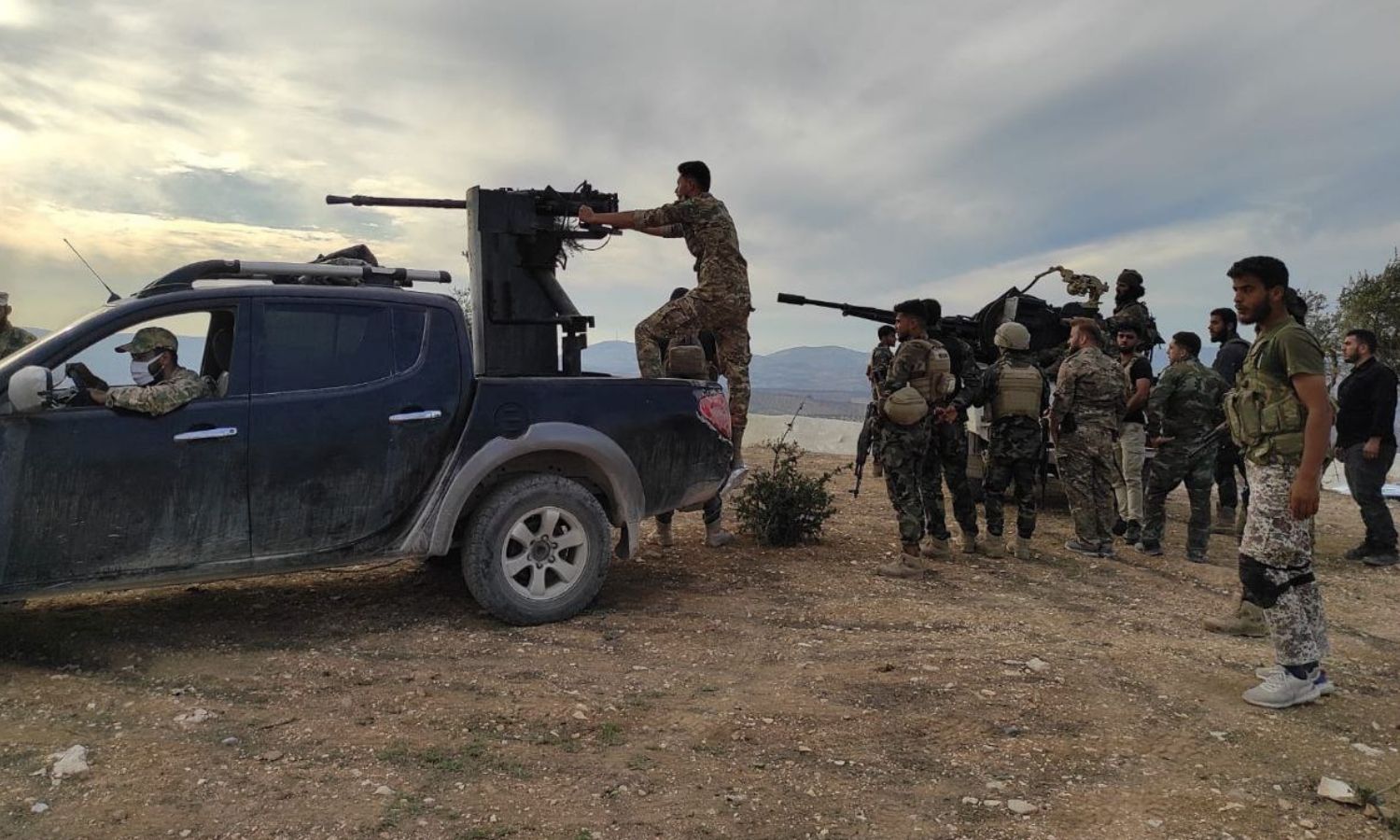
The forces of the Third Legion of the Turkish-backed Syrian National Army in Afrin, north of Aleppo – 12 October 2022 (Third Legion correspondent)
Turkey enjoys wide powers in the joints of the region, especially as it is the main supporter of the military operations during which the SNA factions took control of the countryside of Aleppo (Euphrates Shield and Olive Branch areas), and these powers expanded to include the service and civil sectors, bypassing the military sector.
Turkey owns a number of military bases in the area, which has come to be referred to as Turkey’s areas of influence in northern Syria.
The recent infighting did not record any Turkish position, as it did not support any party and did not participate in mediation or truce until the fourth day of the clashes when the HTS convoys entered Afrin and al-Bab and quickly left. Then it was a guarantor party in an agreement that settled the dispute in favor of Tahrir al-Sham at the influence level.
Ankara-based foreign policy and security analyst Omer Ozkizilcik told Enab Baladi that the HTS has exploited the situation of the National Army and the factional situation and lack of cohesion that it suffers from as part of its expansion policy to become the dominant force and the main actor in the region in its quest to get rid of its designation as a “terrorist group,” but these efforts are “doomed to failure.”
Ozkizilcik considered that the Turkish side is not absent from the recent confrontations, but there are military mechanisms that moved towards Afrin and al-Bab, and this is understood as a “show of strength” and a warning message that Turkey will resort to action in the event that no agreement is reached.
He considered that the issue is not Turkish silence but rather “Turkey’s unwillingness to intervene early.”

A security checkpoint for the Northern Storm Brigade of the Turkish-backed Syrian National Army on the road between the cities of Azaz and Afrin in the countryside of Aleppo – 13 October 2022 (Enab Baladi)
The Turkish analyst Omer Ozkizilcik considered that the Turkish dynamic and its political discourse have not changed due to the developments in the Turkish intelligence relationship with the Syrian regime, especially since these talks did not seem to lead to anything meaningful, and it is unlikely that Turkey will restore its relations with the regime.
On the other hand, Tahrir al-Sham exploits the Turkish discourse on Damascus, which began a few months ago, for its own benefit, and portrays itself as the dominant decision-maker in the region.
The researcher at the Idrak Center for Studies and Consultations, Basil Haffar, told Enab Baladi that the Turkish position on what is happening north of Aleppo was not clear enough, especially with the link between what is happening today in northern Syria and talking about Turkey’s willingness to open up to the regime and Turkey to enter into talks in this regard with Russia.
Haffar considered this talk an important development and a trigger for many issues, including the current fighting, but he did not neglect the tendency of Tahrir al-Sham to “practice domination” over the rest of the factions (a policy that is not new related to Turkish change), and it has previously attacked and dismantled many military entities.
Despite all the negative repercussions of continuing this approach, HTS was allowed to cross from Idlib to northern Aleppo in full view of everyone, including the Turkish guarantor, according to Haffar.
He also considered that the internal fighting and the failure to activate the accountability system is a major threat to the security and stability of this region, which is certainly reflected in Turkey.
Since 2017, the opposition-controlled areas in northern Syria have been divided into two main economic regions: the Aleppo countryside, which is run by the Syrian Interim Government (SIG) with Turkish support, and the Idlib governorate and its surroundings, which is run by the Syrian Salvation Government (SSG) accused of being a political front for the HTS.
Between the two sides spread economic interests, which are reflected in decisions that determine the form of trade, what is permitted and prohibited, and the conditions of movement through the internal crossings.
There are many internal and external crossings in northwestern Syria, some of which connect these areas to the areas of influence of the Syrian regime, including crossings between the same factions and others with Turkey.
During the past years, the northwestern regions of Syria witnessed disputes between the opposition factions over the opening of new crossings or control over the old crossings.
The most prominent of these differences was the Bab al-Hawa border crossing with Turkey, which had previously witnessed battles between the major opposition factions between 2013 and 2015, which ended with Tahrir al-Sham taking control of it under the cover of a civil administration.
Wael Alwan, a political researcher at Jusoor Center for Studies, considered that alliances between opposition factions are always associated with economic benefits centered around crossings or other economic benefits.
Maen Talaa, a researcher at the Omran Center for Strategic Studies, considered that the recent events are gradually turning into gains for Tahrir Al-Sham by extending its influence in the region, especially the issue of crossings.
He pointed out what is meant by the “gains from the crossings issue” not only at the economic level, as it may be important in the matter of the entry of aid to the side of the Bab al-Hawa border crossing, and therefore the HTS will be present as a party on the borders in this area, in addition to the fact that Tahrir al-Sham is trying to export itself as a disciplined force, capable of controlling the scene, and a guarantor of the validity of any agreement in the region.
The National Army and Tahrir Al-Sham areas are linked to two internal crossings, which are the Darat Izza-al-Ghazawiya crossing, also known as Darat Izza Road, and the Deir Ballout-Atmeh crossing, which connects the northern countryside of Idlib with the northern and western countryside of Aleppo.
On the other hand, Tahrir al-Sham manages the Trinbeh-Saraqib crossing alone, in addition to the Bab al-Hawa border crossing and two unofficial crossings, which are Khirbet al-Joz and Atmeh.
While the National Army runs crossings with Turkey, such as Bab al-Salama, Jarablus, al-Ra’i, and others with the Syrian regime, in addition to a crossing with the Syrian Democratic Forces (SDF).
The administration of the National Army of these crossings is divided among its factions, which have previously had disputes over the management of the region’s crossings over the past years.
On 12 May, the US Treasury Department agreed to exempt several Syrian areas out of the regime control from the sanctions imposed under the Caesar Act, allowing 12 sectors, including agriculture, construction, and finance, in the SDF-held areas of northeastern Syria and SNA-held areas in northwestern Syria.
The Treasury issued a statement saying that it had allowed some foreign investments in the areas in northern Syria outside the control of the regime’s government, which it considered a strategy aimed at defeating the Islamic State group through achieving economic stability.
Fears of Tahrir al-Sham’s entry into areas exempted from sanctions, with the ambiguity of the scene about the possibility of its stability there, have raised questions about the future of the local economy and international interaction with these areas, as the HTS is classified as a “terrorist” entity.
Regarding the impact of the current fighting on the region, political economy researcher Yahya al-Sayyed Omar told Enab Baladi that any battles or fighting, regardless of its causes and objectives, has a negative impact on the economy and its indicators. “The economy is growing, and its indicators are improving in light of political, social, and military stability and vice versa,” he added.
The “capital is a coward” and does not take great and unnecessary risks as in light of any real threat, the capital migrates, and the battles affect the levels of supply and demand, and this is what causes an imbalance in the market, so it can be said that the impact of the battles will be negative on the economy in northern Syria, according to the researcher.
Al-Sayyed Omar added that regarding the exclusion of the regions of northern Syria from Western sanctions and the possibility of reversing this exception in the event that the HTS takes control of the region, that this matter is not of great importance and will not cause great harm, as the West’s exception was more of a political issue and position than an economic project.
With regard to the long-term impact of the current military movements, al-Sayyed Omar considered that it is certain that military and political unity is better than dispersal, but the lesson is not only in the union but in the leadership of the union.
In the event of unification under the HTS leadership, the researcher considered that this is a negative matter as a result of the lack of international acceptance of it, and it will strengthen the region’s political and economic isolation and will have a negative impact on the economy of individuals and on macroeconomic indicators in the region.
In 2017, the US classified Tahrir Al-Sham as a “terrorist organization” after it changed its name from Fateh al-Sham Front, which included opposition military factions, the most prominent of which was al-Nusra Front after it broke away from al-Qaeda in 2016.
The faction did not manage to escape the classification after changing the name to Hayat Tahrir al-Sham, as Washington insisted, on 15 May 2017, on enrolling it on the “terrorist” lists, while HTS considers that the Western classifications “miss the truth” and are not based on “concrete facts or evidence.”
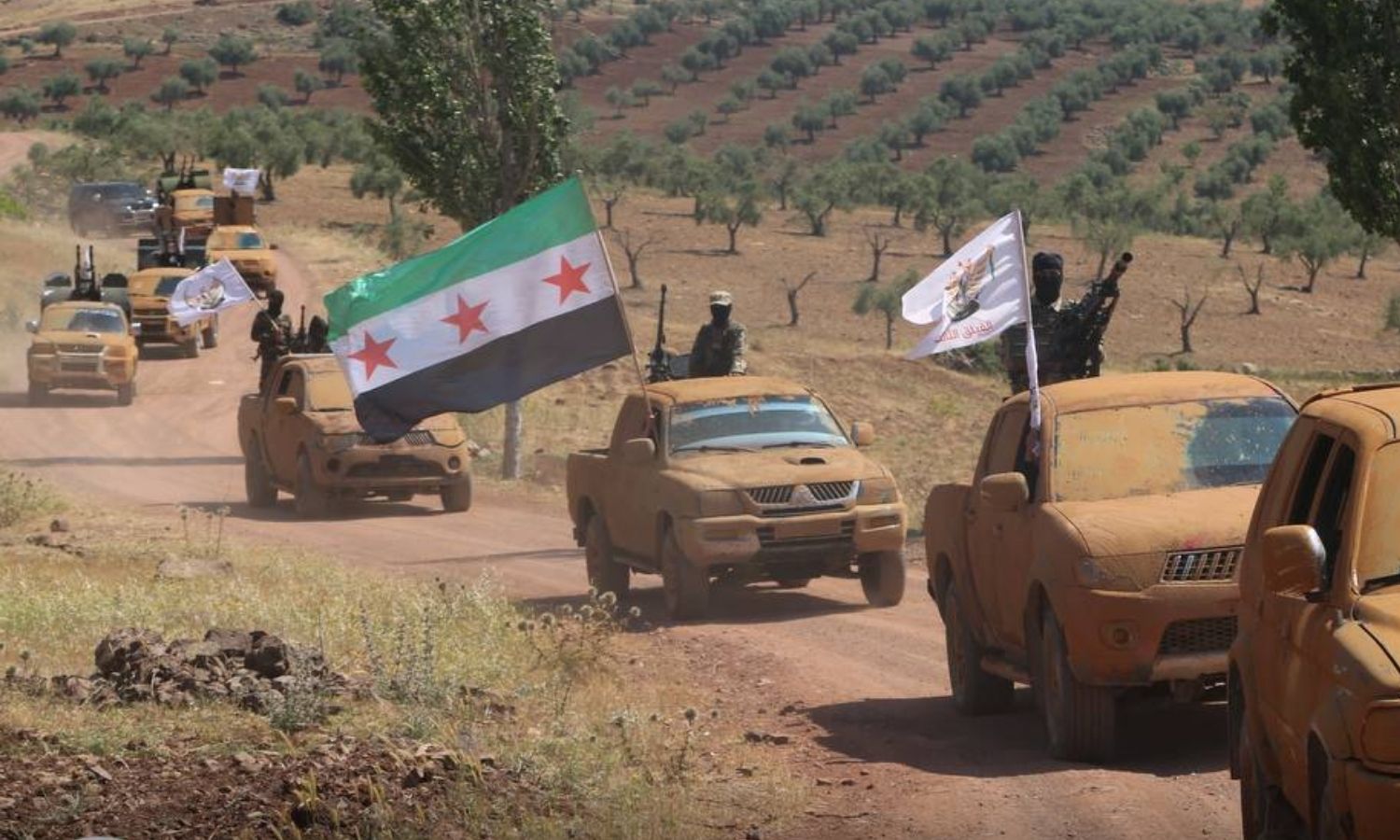
The Third Legion forces in the countryside of Afrin city, north of Aleppo, on their way to fight the factions of Tahrir al-Sham, al-Amshat, and al-Hamzat – 12 October 2022 (Third Legion correspondent / Telegram)
The previous military moves raise questions about the region’s political and economic future amid talk of the possibility of the HTS taking control of new areas in northern Aleppo countryside in partnership with the “compatible” factions of the Turkish-backed SNA.
Maan Talaa, a political researcher at the Omran Center for Strategic Studies, said in his interview with Enab Baladi that with regard to anticipating the region’s future, we can perceive the general trends without acknowledging that they will settle in an “A” or “B” model.
Talaa explained that the general trends in the region can be summed up in three, the first of which is that the talk today about restructuring the Syrian National Army is a case that faces many difficulties and has become behind the current facts, if not “almost impossible” in the foreseeable future.
Talaa added that we are talking today about a severe division, even if the past form of the structure was a factional form within a container called a “National Army.” Today, the discord has become very big between the main forces in this scene.
While the second trend, according to Talaa, is related to the dynamics governing the Turkish areas of influence north of Aleppo, which indicates the strengthening of indicators of self-annihilation.
On the other hand, we find the rest of the areas of control in Syria, whether in the areas controlled by Hayat Tahrir al-Sham or the Autonomous Administration of North and East Syria (AANES) or the Syrian regime is facing questions of self-empowerment, such as building networks, according to Talaa.
| Self-annihilation is the set of factors that form within a single structure that leads to its end. It does not need an external force to take place, as clashes, conflict, cracking, and inter-fighting are sufficient to transform the group’s effect into zero and completely absent from the scene. |
Despite the crises that exist in all areas of control, the conditions and context of the political freeze, the freezing of the scene in Syria, and the temporary ceasefire are being employed for self-structure benefits, according to researcher Maan Talaa.
“In the areas of Turkish influence, we find that this indicator is a continuation of several indicators indicating the approaching or maximizing the dynamics of self-annihilation and this form is far ahead of its predecessor,” he added.
Regarding the third trend of the region, Talaa considered that it is mainly linked to the Third Legion, which claims that its main forces are local forces, and therefore it is facing major challenges, either to remain in its fractional form as local components or to go towards exploiting this opportunity and considering what has happened as an “operation of real purification and rebuilding of an effective nucleus in the form of a fighting military body, with a military doctrine and a military geographic logic, not a factional logic,” Talaa said.
He believes that this increases the challenges of the Third Legion, since its options in the coalition have become few, and its current alliances are those of interest, which will make its current movements the element that will control the third direction of the region.
In the researcher’s estimation, if the Third Legion goes towards a real building that is not based on factional ideology or the rejection of political, representative, and administrative forces and manages its relationship more effectively with the Turkish side, it will somewhere be a nucleus for the formation of a national political-military body.
Whereas “if the issue remains a quota system, a controlling families issue, or a faction issue, then we are only facing a postponement of the existential examination of the Third Legion, Talaa concluded.
if you think the article contain wrong information or you have additional details Send Correction